UNESCO World Heritage Sites in Poland
From impressive medieval castles to spectacular primeval forests – undoubtedly, Poland is a country with a rich historical tradition and full of natural beauty. It attracts tourists with picturesque old towns, extraordinary palaces, charming wooden churches, and incredible underground salt mines – traveling across our country provides memorable cultural experiences. Therefore there is no surprise in the fact that some of these places have been well rated by the World Heritage Committee and placed on the prestigious UNESCO World Heritage List. Go through our short guideline and discover sites of the Polish national pride!
Table of contents (and quick links for your convenience):
- Krakow Old Town
- Wieliczka & Bochnia Salt Mines
- Auschwitz-Birkenau Nazi German Concentration and Extermination Camp
- Bialowieski National Park
- Warsaw Old Town
- Zamosc Old Town
- Medieval Town of Torun
- Malbork Castle
- The Mannerist Architectural and Park Landscape Complex and Pilgrimage Park in Kalwaria Zebrzydowska
- Churches of Peace in Jawor and Swidnica
- Wooden Churches of Southern Małopolska
- Muskau Park (Park Muzakowski)
- Centennial Hall in Wroclaw
- Wooden tserkvas of the Carpathian region
- Lead-Silver-Zinc Mine in Tarnowskie Gory
- Neolithic Banded Flint Mine in Krzemionki Opatowskie
Krakow Old Town
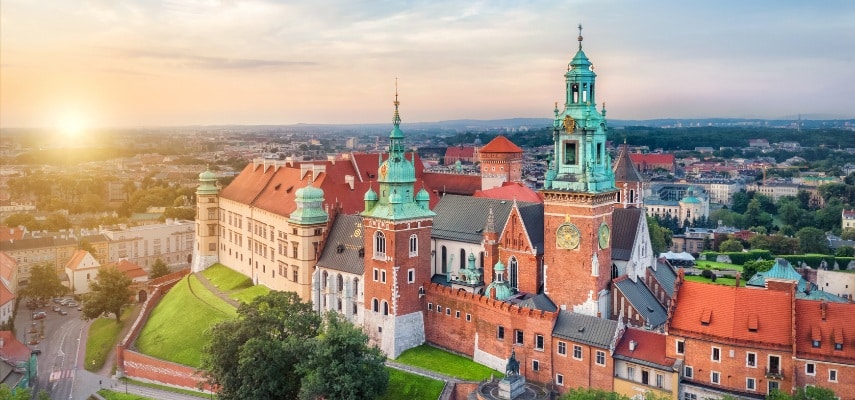
Located on the Vistula River, Krakow is the cradle of Polish culture with a unique complex of historical sites. The oldest ones date back to the 11th century. The total number of historical buildings exceeds 3000!
The most distinctive point of the city is Main Market Square from the middle of the 13th century. The square is a starting point for most of the city tours. Surrounded by rows of townhouses, it was the largest town square in medieval Europe. Two impressive buildings dominate the square: The Cloth Hall (Sukiennice), with stalls from the 13th century, continues the centuries-long tradition of trade. The second most famous building is St. Mary’s Basilica. It boasts the largest Gothic altarpiece in Europe: the 15th-century wooden polyptych made by the incredibly gifted sculptor Veit Stoss. An hourly bugle call, played from the tower of St. Mary’s Basilica, commemorates a legendary trumpeter who was shot dead by the Tatars trying to conquer the city in the 13th century.
Let’s leave Main Market Square and move along Kanonicza Street to reach Wawel Hill with its numerous attractions. It is a place that has witnessed the development of the Polish state and culture. The main attractions there include the Royal Castle, the Cathedral with royal tombs, and the pearl of Renaissance architecture: Sigismund’s Chapel with its arcade courtyard.
A few steps away from the Old Town, the Kazimierz district begins. It was historically a Jewish quarter from the 14th to the 19th centuries. Today, it is known for its artsy and bohemian nightlife, enjoyed in local cafes, restaurants, and galleries. The heart of the area is Szeroka Street, home to synagogues of significant historical value, including the Old Synagogue and the Remuh Synagogue.
The Podgorze district, once the site of the former ghetto and close to Oskar Schindler’s factory, is also worth visiting.
Wieliczka & Bochnia Salt Mines
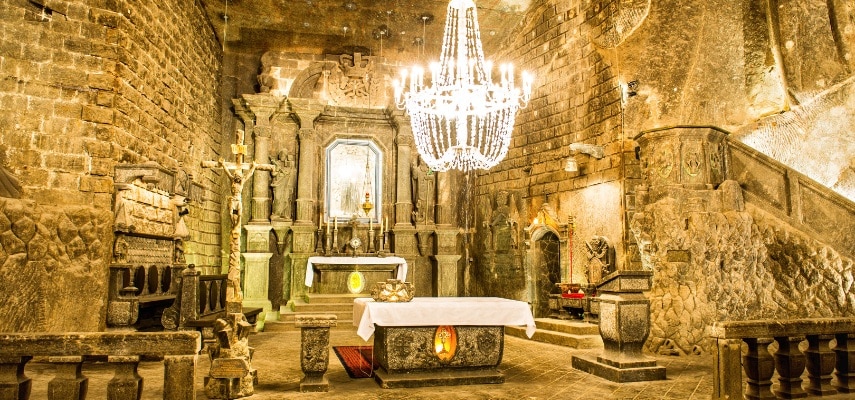
Welcome to the extraordinary underground world, a true kingdom of salt formed by an underground labyrinth of chambers and corridors carved out of salt.
The Wieliczka Salt Mine stands out as the only mining facility in the world that has been operating continuously since the 13th century! The area open to the public stretches over two kilometers, showcasing marvels entirely made of salt: chapels adorned with intricate salt sculptures, serene salty lakes, ancient excavations with preserved wooden structures, and historical mining tools. The highlight of the tour is St. Kinga’s Chapel – take a moment to close your eyes and immerse yourself in its exceptional acoustics! Here, the air you breathe is among the cleanest globally, entirely free from pollution or allergenic particles. For those seeking a unique experience, consider spending a night in one of the special saline chambers for a restful sleep away from the hustle and bustle of city life, where a night without nightmares is guaranteed!
The second underground gem, the Bochnia Salt Mine, may not be as well-known as Wieliczka, but it offers its own captivating experiences. Being older by several decades, it invites you on a fantastic journey through its most beautiful and intriguing excavations. You’ll discover chambers with unique shapes, simple yet awe-inspiring underground chapels decorated with exquisite sculptures and paintings, as well as mining tools and equipment from past centuries. Not to be missed is the underground boat cruise through the mine’s flooded sections, alongside the stunning display of fluorescent halite crystals found along the natural path. Make sure to explore these incredible attractions!
Auschwitz-Birkenau Nazi German Concentration and Extermination Camp
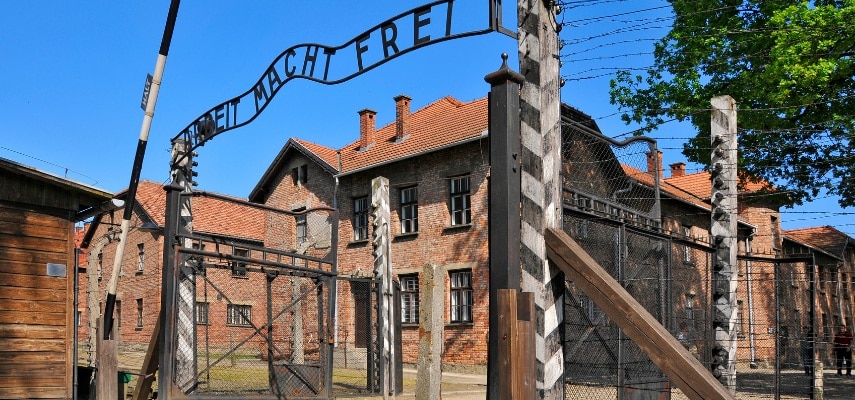
Imagine standing at the edge of a vast, dark ocean, with waves of history crashing against the shore. This is the profound experience of entering the Auschwitz-Birkenau State Museum, a beacon shining light on the darkest chapters of the Holocaust and World War II. Located in Oswiecim, a Polish town occupied by Nazi Germany, Auschwitz began as a detention center for Polish political prisoners. However, it quickly evolved into the largest extermination site for European Jews, among others persecuted by the Nazis.
The site comprises two main parts: Auschwitz I, initially the smaller camp known for its deceitful gate inscribed with “Arbeit Macht Frei” (Work Sets You Free), and Auschwitz II-Birkenau, the much larger section recognized by its wooden barracks, foreboding guard towers, and the infamous railway ramp where countless were selected for death or forced labor. The weight of this place is palpable, bearing heavily on the hearts of its visitors. Yet, it serves not only as a memorial to those who suffered and perished but also as an educational resource. The museum meticulously preserves documents, relics, and testimonies from that era, serving as a solemn reminder of the atrocities committed, ensuring that the world never forgets.
You can visit Auschwitz on a private tour – visit this page for more details.
Bialowieski National Park

Step into a living time capsule: Poland’s Białowieża Forest, a UNESCO-listed natural heritage site and Europe’s last remaining primeval forest. It’s a vibrant tapestry of life – rich, varied, and untouched. Venture deeper, and you might encounter a wolf on the prowl, a sleek lynx, or even a playful otter. But the forest’s crown jewel? The European bison, or żubr. Home to over 500 of these majestic creatures, the forest offers a unique chance to observe them in their natural habitat. Embark on the forest’s educational trail to find bison-viewing spots and encounter ancient trees named after Polish kings. A journey here is akin to wandering through nature’s most grandiose storybook.
Bialowieza Forest is a perfect place to rest in direct contact with extraordinary nature. Take a tour to Bialowieza Forest and feel you are breathing differently.
Warsaw Old Town
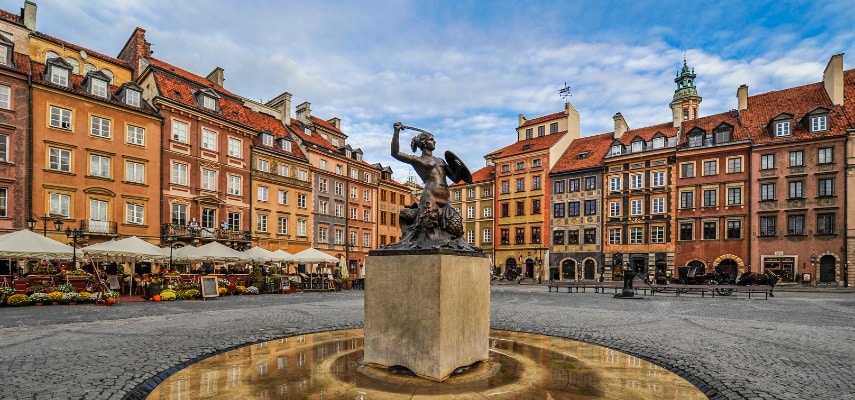
The Polish capital was enormously damaged during World War II. More than 85% of the historic city center was destroyed during the Warsaw Uprising by the German army in 1944. Colorful tenement houses, churches, centuries-old palaces, and the Royal Castle ceased to exist in seconds. Thanks to the local authorities and renowned architects, the Old Town arose like a phoenix from the ashes in just a few years. The scale and precision of the work were impressive. The architects managed to reconstruct the city to reflect the architectural style and glory of the seventeenth and eighteenth centuries.
Now, the historical part of Warsaw is teeming with life. Restaurants, café gardens, old shops, galleries, everything is at your fingertips. To appreciate the magnitude of the reconstruction work, climb the bell tower of Saint Anne’s Church. The view is stunning!
Zamosc Old Town
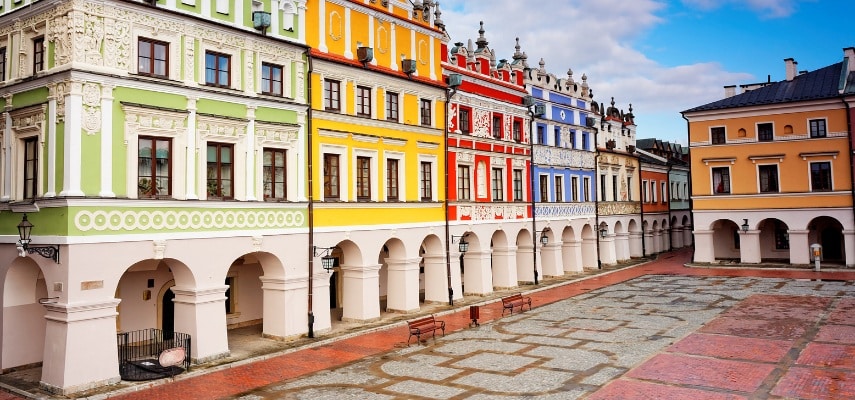
Zamosc, nestled far from the hustle of major cities, stands as a pristine example of the Renaissance concept of an “ideal town.” Established in 1580 by Chancellor Jan Zamoyski, the city is a harmonious blend of beauty and functionality. Its layout, inspired by Renaissance ideals, reflects the proportions and harmony of the human body. Architect Bernardo Morando’s master plan skillfully merges Italian and Central European architectural traditions. At its heart lies the impressive Great Market Square, anchored by the towering Town Hall and the collegiate church, surrounded by colorful tenements and arcades that play with light and shadow.
Stroll down Grodzka Street to encounter other historic marvels: the Zamoyski Academy buildings, a late-Renaissance synagogue, the former Chancellor’s Palace, and the Arsenal. Encircled by formidable fortifications, including seven bastions, the city’s past defenses invite exploration, with their remnants now accessible to the public—a highlight not to be missed during your visit.
Visit Zamosc and witness the realization of a visionary’s dream: a city that embodies the essence of the Renaissance, rightfully earning its title as “the pearl of the Renaissance”!
Medieval Town of Torun
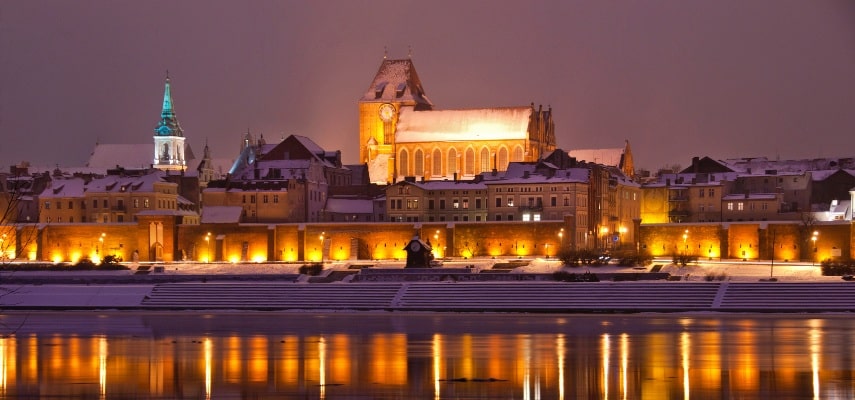
Torun is one of the oldest towns in Poland. You might have heard of it as the birthplace of Nicolaus Copernicus, the famous astronomer known metaphorically for stopping the Sun and moving the Earth. Of course, Torun’s placement on the UNESCO list isn’t solely due to this historical figure. The city has much to offer all types of city explorers, and by “much,” we mean more than just the world-famous gingerbread.
Visiting Torun is like traveling hundreds of years back in time. Founded in 1233 by knights of the Teutonic Order, it draws attention with its authentic layout and Gothic architecture, preserved for centuries. Here, you can find the most authentic monuments of Gothic art and architecture in Poland.
Entering the old town through one of its medieval gates opens up a wealth of monuments and charming places. The most valuable sites include the Town Hall with its 40-meter observation tower, mysterious medieval churches, ruins of the Teutonic castle, and numerous granaries. Gazing at the well-preserved medieval city walls, one can imagine the power of ancient Torun.
During a pleasant walk through Torun, we recommend stopping at the reconstructed bakery from the 16th century – the Gingerbread Museum. There, you can bake a sweet souvenir according to a traditional recipe. Yes, a visit to Torun would be incomplete without tasting the gingerbread!
Malbork Castle
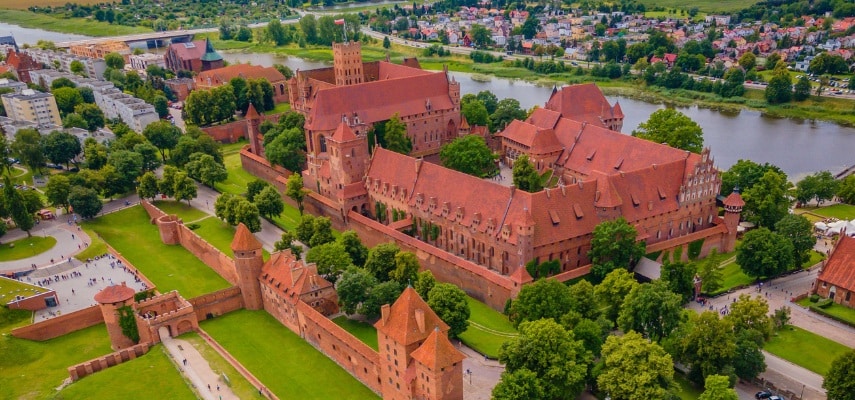
Welcome to the world’s largest stronghold made of brick. The castle, built with 4.5 million bricks, is the first example of a regular four-wing defense fortress. It consists of three major structures: the High, Middle, and Lower Castles, separated by towers and dry moats.
The High Castle was built in the 13th century and is the oldest part of the complex. It is worth seeing here The Blessed Virgin Mary Church and St. Anne’s Chapel, which served as a tomb chapel for the grand masters of the Order.
In the Middle Castle, you should pay a visit to the Great Refectory to see the most representative secular interiors of medieval Europe. You cannot leave the spot without visiting the significant exhibition of amber, which houses Poland’s most extensive collection of this natural substance and objects.
Last but not least is the Lower Castle with an arsenal, a bell foundry, stables, a brewery, and Saint Lawrence’s Church. Vast moats and awe-inspiring defensive walls surround the entire complex.
Malbork Castle seems to be a perfect destination for a city break. All you need is to book a flight ticket to Gdansk, hire a car at the airport, and head south to Malbork. The fastest route is the A1 highway and the DK22 road, and the drive should take about 1 hour. Another idea is to take a guided tour from Gdansk to Malbork. A trip organized by professionals lasts 5 hours.
The Mannerist Architectural and Park Landscape Complex and Pilgrimage Park in Kalwaria Zebrzydowska
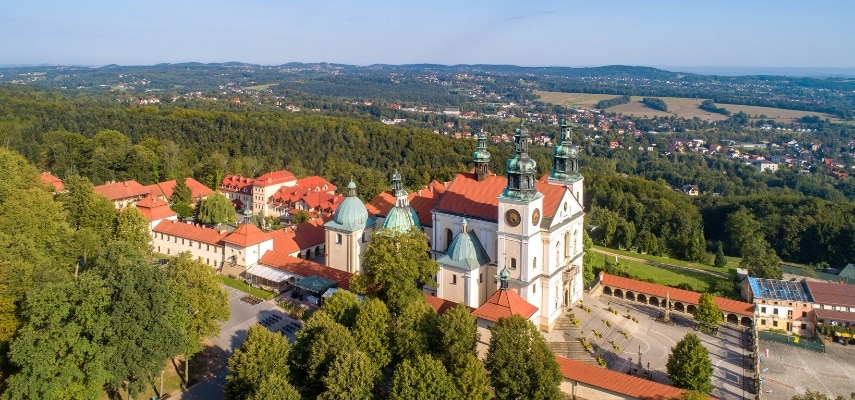
In the picturesque scenery of the Beskid landscape, there is a religious place known as one of the leading destinations for pilgrimages in Poland. According to legend, a local magnate, Mikolaj Zebrzydowski, saw a burning cross and decided to build a monastery at the site of his miraculous sighting.
The complex comprises a Baroque basilica with the Holy Icon of the Mother of God of Kalwaria, as well as Baroque and Mannerist churches and chapels. During Holy Week, an impressive Golgotha staging is held here.
If you are looking for a pilgrimage tour, this is definitely an obligatory place to visit.
Churches of Peace in Jawor and Swidnica
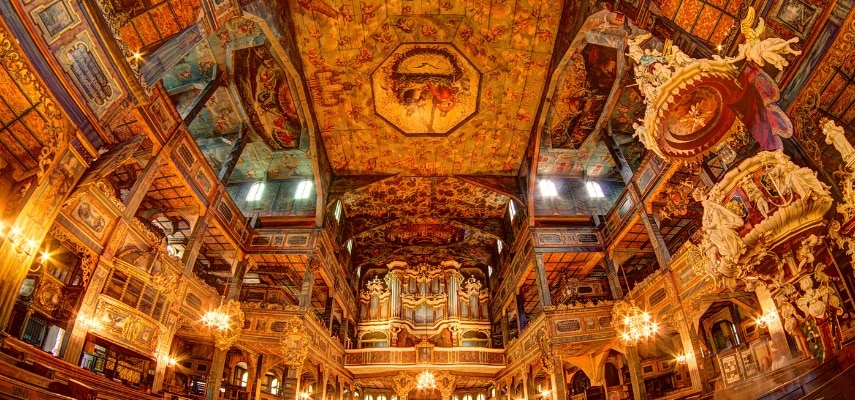
Made of wood and clay, they should have turned to dust in a short time. Fortunately, they have survived the restless centuries and still delight curious explorers of Lower Silesia.
These beautiful Protestant churches were built in the second half of the 17th century as a manifestation of religious tolerance in the Habsburg monarchy. They serve as an example of a harmonious combination of Baroque art forms and Lutheran ideology. First-time visitors are usually amazed by the interiors, where extraordinary richness contrasts with the modest architectural style. It is worth stopping for a moment to listen to the famous organ concerts held in these temples. Their impressive acoustics will enchant you, even if you are not a lover of organ music.
Wooden Churches of Southern Małopolska: Binarowa, Blizne, Debno, Haczow, Lipnica Murowana and Sekowa
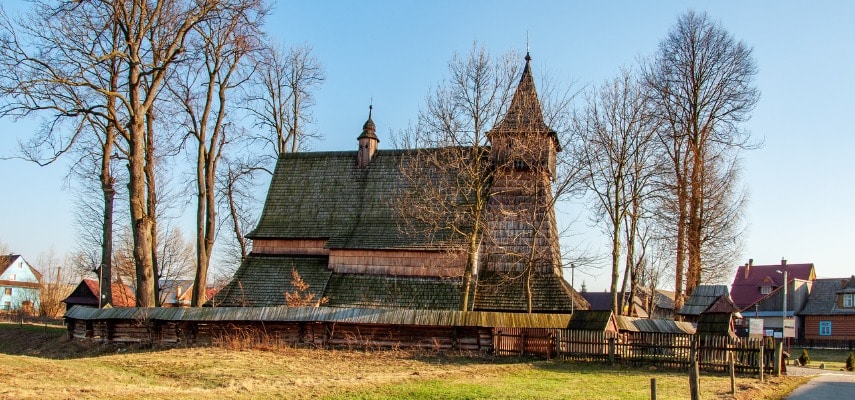
They were inscribed in 2003 as outstanding examples of the different aspects of medieval church-building traditions in Roman Catholic culture. As part of priceless historical objects included in the Wooden Architecture Route, they captivate with their artistry and furnishings of high artistic value. They were usually built from larch or fir timber, with walls made of entire logs without any nails, but by connecting individual elements through interlocking wooden logs. The interiors, a veritable gallery of decorative arts, always make an impression on visitors, especially the crucifixion group from the church of St. Michael the Archangel in Dębno and the scenes from the New Testament in Binarowa. If you are a music enthusiast, you should make a stop at St. Leonard’s Church in Lipnica Murowana, where a positively valued chest organ instrument is showcased.
Muskau Park (Park Muzakowski)
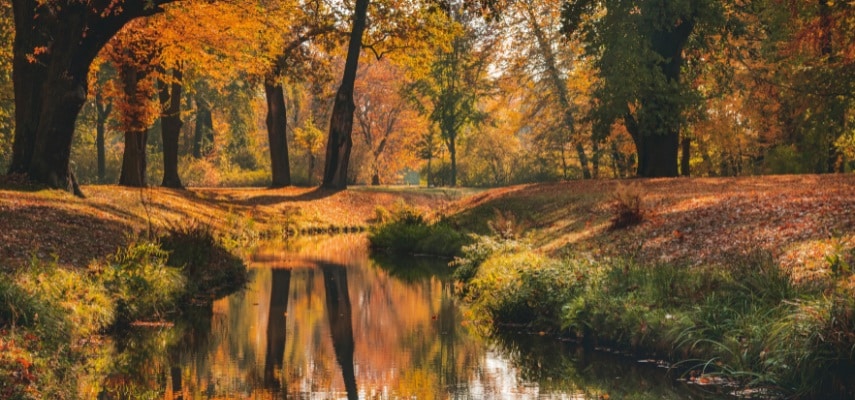
Ever dreamt of stepping into a painting? This vast English-style park straddling Poland and Germany might just be your chance. Seamlessly woven between two nations via the Double Bridge and the English Bridge, it’s a testament to Prince Hermann von Puckler-Muskau’s love for nature and art. After basking in the beauty of English gardens throughout Europe, he felt a burning desire to birth his own masterpiece around his family’s Bad Muskau manor. And what a masterpiece it is! Think of it as an artist’s canvas, but instead of paints, the strokes are made with plants. This park beautifully highlights the serenity and charm of the local landscape.
And while you’re there, strolling and taking it all in, don’t miss out on some standouts: the soaring Viaduct, the regal Prince’s Bridge, the captivating Bridge over the Gorge, and the ornate Royal Bridge flaunting its intricate balustrade. As you wander, let your eyes and heart wander too – to the gentle ponds, the whispering streams, quaint garden houses, and viewpoints that’ll steal your breath away.
Centennial Hall in Wroclaw
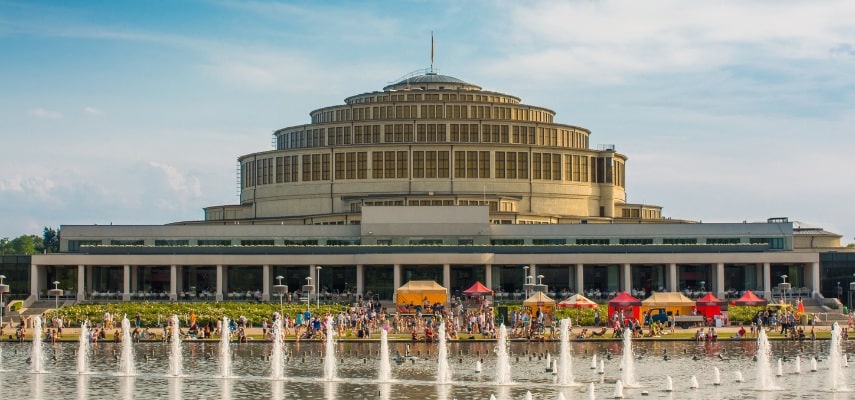
Not far away from the center of Wroclaw, rated as the most buzzling Polish city, there is an engineering marvel of the 20th century. The Centennial Hall was built in 1913, for the one-hundredth anniversary of the allied defeat of Napoleon, as a place for exhibitions presenting the history and economic output of Silesia. The city architect, Max Berg, prepared a project using reinforced concrete technology, which has not been used on such a huge scale those days. He planned to build the hall on the site of the closed race track, in the Szczytnicki Park. Initially, the project did not appeal to city councilors, who compared Hala’s body to a hatbox or a gas meter. Fortunately, their opinion did not negatively affect the final result, and today we consider it a truly ground-breaking project in the history of world architecture.
The dome of Wroclaw’s gem has a span of 65 meters, and the body of 42 meters high, which overshadows Rome’s Pantheon! Today, the Hall serves as a multi-purpose venue for various large-scale events. It hosts cultural and sporting events, exhibitions, music concerts, conferences, and congresses, both local and world standing. Even the surrounding area has a lot to offer – a Japanese garden with its main attraction, Pergola, will melt your heart with the same intensity as a UNESCO Heritage object.
Wooden tserkvas of the Carpathian region: Brunary, Chotyniec, Kwiaton, Owczary, Powroźnik, Smolnik, Turzańsk, Radruz, Smolnik and Turzansk
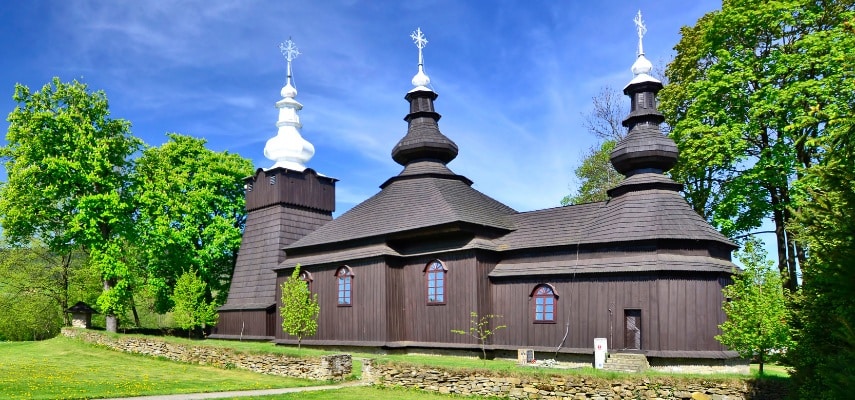
In the verdant embrace of the Carpathia mountains lies a secret. Lesser Poland (Malopolska) and Podkarpackie Voivodeship harbor wooden marvels, often perched on gentle hills, cocooned by trees. These aren’t just buildings; they’re a testament to age-old craftsmanship. Constructed purely from wood, predominantly evergreens, each structure reveals a signature style: a western entrance and sun-kissed windows on the southern facades. Delve deeper into their design, and you’ll see a tri-fold beauty: the holy presbytery, the expansive nave, and a secluded women’s gallery, usually nestled under a watchful tower. Their high mansard tented roofs, crowned with unique onion-shaped domes and ornate false lanterns, tell tales of architectural brilliance. Don’t be surprised to find an accompanying bell tower nearby. Within these wooden walls, intricate iconostases and vibrant polychrome artistry beckon. Notably, Owczary houses an 18th-century iconostas of unparalleled beauty, while Turzansk holds keys to an even older treasure.
Lead-Silver-Zinc Mine in Tarnowskie Gory
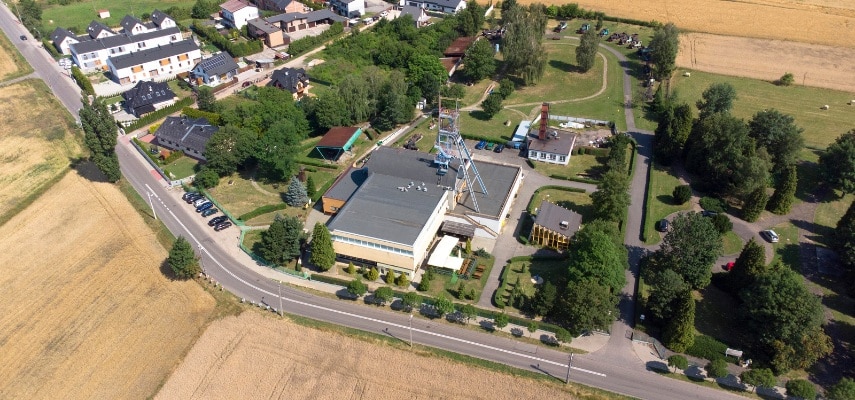
Formerly aroused the admiration of European aristocracy, currently delights tourists from all over the world. It is like an underground city – at a depth of 40 meters, there is a maze of corridors of the former silver, lead, and zinc ore mine Fryderyk. Taught conditions – low temperature and high humidity – let you feel the atmosphere of former mining work. Warm clothes and suitable shoes will be useful there! During the journey, tourists watch transport sidewalks of varying heights and vast chambers built at the turn of the 18th and 19th centuries and will become acquainted with the methods of extracting silver, lead, and zinc ores.
A unique installation illustrating the operation of the first steam engine in this part of Europe is a real eye-catcher! One of the biggest attractions is the flow of boats on a 270-meter route. And for dessert, let us return to the bosom of nature, admiring the only lesser karst in Europe located in a former mine, and crystal clear water attracting several species of fish.
Neolithic Banded Flint Mine in Krzemionki Opatowskie
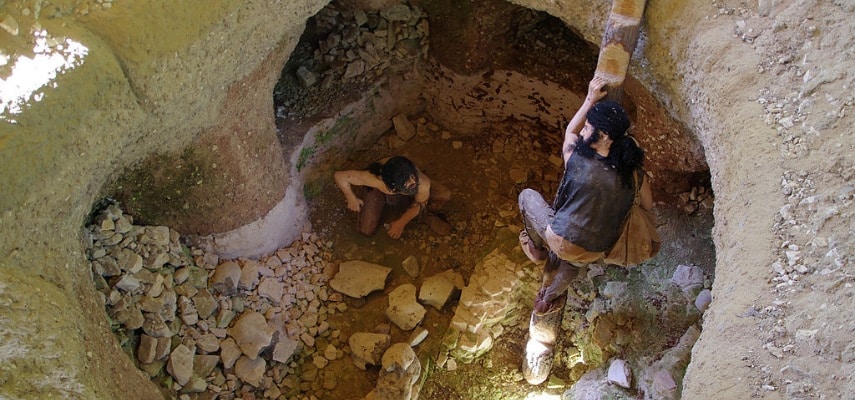
The newest attraction on UNESCO Heritage List, it’s one of the most important relics of prehistoric mining sites in the world. Here, over 5000 years ago, humans started the excavation of flint, which was called the gold and steel of the Neolithic Age. Despite the passage of time, it has remained virtually unchanged to this day. Traveling along the 500-meter tourist route, the tourists will learn the history of everyday life in the Neolithic Age and the early Bronze Age. In an ancient village, you can find a reconstruction of a Megalithic tomb and mining camps, which also function as a site for workshops and archaeology demonstrations. The unique category of the place and its closeness to nature make a visit to Krzemionki an unforgettable experience. Feeling curious?



User Comments (0)